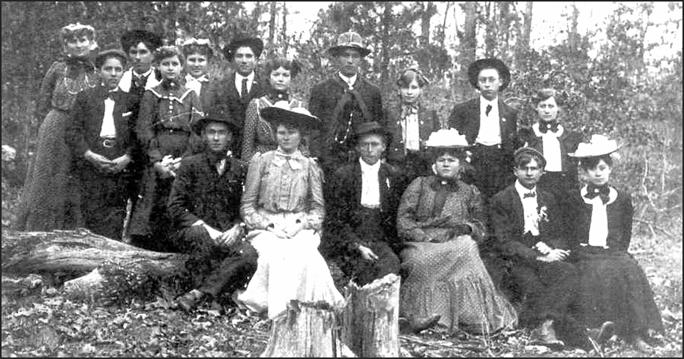

The Indians were gone at Gravel Hill by 1904 when this fashionably attired young group gathered for a photo. They are (from left to right):
Standing – Dora Etta Vardell (who married David Frank Stringfellow in 1907),; James Oscan Stringfellow (who married Myrtle Benton in 1914),
David Frank Stringfellow, Chrissy Walker, Lucy Ellen Hill (married J.B. Strickland in 1909), Walter Greeley Burkett (married Noran Covington
in 1905), Edna Burkett (married W.L. Stringfellow in 1907), William Luther Stringfellow, Effie Benton (married Adolphus Norman in 1908),
Dolph Quattlebaum, Josie Scott (married Dolph in 1909); Seated - Grover West, Minnie Barnett (married Grover West), Walter Quattlebaum
(married Minnie Lawson in 1907), Lanta Mae Vardell (married J.C. Hughes in 1911), Daniel Webster Barnett, and Virginia O. (Thielia) Scott
(married D.W. Barnett). .
By Dr. Calvin C. Turpin
Edmond, Oklahoma
W
hile the name “Arkansas” is a Siouan word, many do not think of Arkansas as being Indian Territory. The state’s name seems to have come from Acansa,
a Quapaw village in southeastern Arkansas. Early day non-Indian neighbors often referred to the Quapaws as Acansa, Alkansea, or Arkansas. There were
three large areas of Native Americans within the state: Osage (northwest), Caddo (southwest), and Quapaw (most of the eastern ½ of the state), plus a
small Tunica group near the southeast borders.
When I was a lad growing up in the Gravel Hill community (western part of White County) one could find evidences of early Indian presence. My family
owned a very large farm in Gravel Hill. It was located on present day Mockingbird Lane ¾ mile west of Gravel Hill Road. Most of our farm lay north of
Des Arc Creek; however, a portion was across the Creek on the south side. According to anecdotal information, there was an Indian campground and
cemetery on that portion extending south of Des Arc. I remember a number of mounds that could have easily given evidence of Indian presence and
activity. I used to walk the area searching for Indian arrowheads. I was rewarded with a lot of beautiful ones. While most of my arrowheads came
from that area, I found them in various places over our large holdings. If they had come from either a single or even small place
it might be assumed someone had either lost or planted them there. It is most unlikely that someone would have deliberately scattered arrowheads over
such a wide area. When I entered the Army in 1943 I left a large shoebox full of arrowheads with my parents who are now deceased. I regret I do not
know what became of them because today they would be treasures. I think the points were of Quapaw origin.
Another evidence of Indian presence in Gravel Hill was a single grave on the farm of my mother’s aunt and uncle: Walter and Minnie Quattlebaum. It was
located about 1/8 mile west of Gravel Hill Road on Romance Road and then about 1/8 mile south in a field. Anecdotal information stated it was the
grave of an Indian girl. Uncle Walter and Aunt Minnie, having placed a small fence around the grave, tended to it with much respect. I often walked
by it on my way to school. While I never saw a Native American in Gravel Hill, I saw enough evidence to convince me, a historian, of past Indian
presence. Gravel Hill can be proud of its Indian heritage! For those who might wish to travel to Gravel Hill, go west from Searcy on Highway 36
through Center Hill to Joy, turning south on Gravel Hill Road until you come to the great community. vvv


